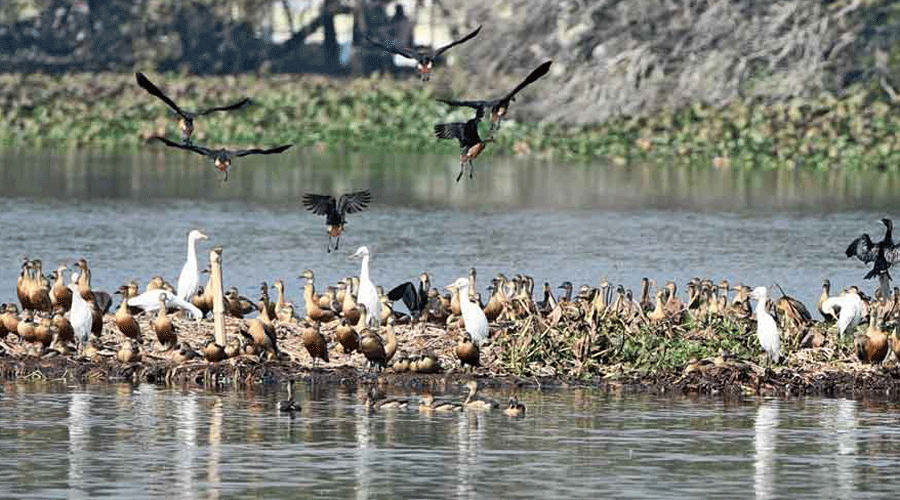The Mangalore University campus, situated near here and spread over 353 acres, hosts a variety of bird species including three near-threatened species mentioned in the red list of the International Union for Conservation of Nature (IUCN), a study has revealed.
The study, ‘A checklist of avifauna of Mangalore University’ by five researchers, was published in the 'Journal of Threatened Taxa,' an international scientific journal on conservation, on January 26 last.
The nine-year study from 2013 to 2021 was conducted by researchers and birdwatchers K Maxim Rodrigues, K Vineeth Kumar, Vivek Hasyagar, M C Prashanth Krishna and Deepak Naik.
The study recorded a total of 150 bird species belonging to 18 orders and 56 families in the campus which was published in the international journal, Maxim Rodrigues, one of the researchers, told PTI.
The study found that the campus hosts three near-threatened (NT) species of birds in the IUCN red list, namely Ciconia episcopus (woolly necked stork), Threskiornis melanocephalus (black headed ibis) and Brachypodius priocephalus (grey headed bulbul).
The campus also supports five species (Brachypodius priocephalus, Rubigula gularis, Argya subrufa, Sturnia blythii, and Dicaeum concolor), which are endemic to the Western Ghats, the study found. The remaining species are under least concern (LC) in the list.
The feeding guild analysis of birds revealed that the insectivorous group had the highest number of species (53). The study provides baseline data for monitoring the avifauna in the campus and demonstrates the importance of the area in bird conservation.
An analysis of the feeding guilds of these birds revealed that 53 species were insectivorous, 42 species (omnivorous), 34 species (carnivorous), nine species (granivorous) and four species each were frugivorous and nectivorous respectively.
During the nine-year study period, 124 bird species were reported as residential, while 13 species were identified as long-distance migratory birds and 13 species were local migratory birds.
The study was conducted in the campus, situated 20 km away from Mangaluru city. The sprawling campus consists of different habitat types such as laterite, shrubby patch and orchards.
The bird exploration was conducted for a period of nine years to maintain the baseline data in the Mangalore University campus. The data was collected by opportunistic encounters during the regular field visits, the study report says.
"The team members visited the campus whenever it was convenient for them and recorded their findings. In February, all will be there as part of the global bird count," Rodrigues said.
The study provided important baseline information and the importance of species presence. This will help in the long-term monitoring of birds in the campus besides acting as an essential document in planning conservation efforts in the camp, the report says.
Only a few ornithological studies have been carried out in the Dakshina Kannada region earlier. In 2001, a study by Ramitha and Vijayalaxmi in the entire region reported 56 species of birds belonging to 31 families.
In the study, they had also covered the university campus along with adjoining areas like Pavoor, Assaigoli, Someshwara and Nethravati bridge, Rodrigues said.
Except for this, no detailed long-term studies have been made on the diversity of birds in the study area. In this context, the present study was undertaken to highlight the status, composition, feeding guilds and diversity of birds in the campus, the study report says.
Rodrigues said the annual campus bird count in India, promoted by Bird Count India Collective as part of the Great Backyard Bird Count (GBBC), will be held at various campuses in the country including Mangalore University from February 17 to 20 this year.
The GBBC was first launched in 1998 by the Cornell Lab of Ornithology of Cornell University in Ithaca and National Audubon Society in Manhattan, New York.
Rodrigues, who is the founder of Kasaragod Birders collective based in Kasaragod district of Kerala, said check lists of birds in the campus will continue to be recorded every year.
He said the university authorities were very co-operative in conducting the observation and research on birds.
Among the other members of the team, Vivek Hasyagar is a research scholar working on earthworm ecology with the department of Applied Zoology at the Mangalore University and an avid birdwatcher.
Vineeth Kumar is engaged in education and research and his interests include ecology and behaviour of amphibians and aves, biodiversity, acoustic behaviour and migration of birds.
Krishna, presently working as a chemist, is a keen birdwatcher who focuses on documentation of birds in and around Dakshina Kannada and Kasaragod districts.
Deepak Naik is currently a guest faculty in the department of Applied Zoology at the Mangalore University. His research interests are on butterfly communities, birds and ecology in different landscapes.
Except for the headline, this story has not been edited by The Telegraph Online staff and has been published from a syndicated feed.











